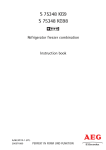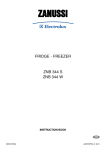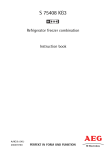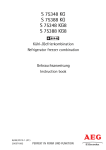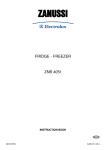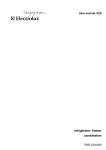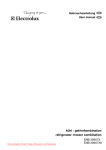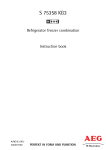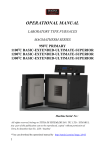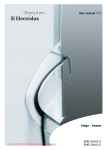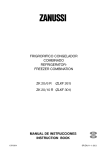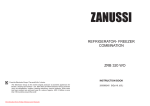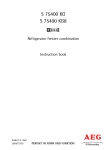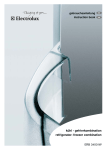Download Electrolux ENB 43693 X Technical data
Transcript
KOEL/VRIESCOMBINATIE - RÉFRIGÉRATEUR CONGÉLATEUR - KÜHL GEFRIERKOMBINATION - REFRIGERATOR- FREEZER COMBINATION GEBRUIKSAANWIJZING - MODE D`EMPLOI - GEBRAUCHSANLEITUNG - INSTRUCTION BOOK ENB 3450 NL FR DE GB 200370313 Downloaded from Fridge-Manual.com Manuals B/E/4. (05.) GB Before installing and using the appliance read this user's instruction book carefully. It contains safety precautions, hints, information and ideas. If the refrigerator is used in compliance with the instructions written, it will operate properly and provide you with greatest satisfaction. The symbols below help you to find things more easily: Safety precautions Warnings and information at this symbol serve safety for you and your appliance. Hints, useful information Environmental information Symbol for ideas At this symbol ideas can be found according to food and its storing. The symbol on the product or on its packaging indicates that this product may not be treated as household waste. Instead it shall be handed over to the applicable collection point for the recycling of electrical and electronic equipment. By ensuring this product is disposed of correctly, you will help prevent potential negative consequences for the environment and human health, which could otherwise be caused by inappropriate waste handling of this product. For more detailed information about recycling of this product, please contact your local city office, your household waste disposal service or the shop where you purchased the product. From the Electrolux Group. The world’s No.1 choice. The Electrolux Group is the world's largest producer of powered appliances for kitchen, cleaning and outdoor use. More than 55 million Electrolux Group products (such as refrigerators, cookers, washing machines, vacuum cleaners, chain saws and lawn mowers) are sold each year to a value of approx. USD 14 billion in more than 150 countries around the world. 63 Downloaded from Fridge-Manual.com Manuals GB Cont ents Important safety information ..................................................................................................65 General safety precautions ....................................................................................................65 Precautions for child safety....................................................................................................65 Safety precautions for installation ...........................................................................................65 Safety precautions for isobutane ............................................................................................65 Instructions for the User.........................................................................................................66 General information..............................................................................................................66 Description of the appliance, main parts ..................................................................................66 Switch and indicator set ........................................................................................................67 Display background colour................................................................................................68 Handling the appliance .........................................................................................................68 Putting it into use.............................................................................................................68 Controlling the temperature, setting ....................................................................................68 How to use the refrigerator................................................................................................68 Drawer...........................................................................................................................69 Shopping mode ..............................................................................................................69 Storing in the refrigerator ..................................................................................................69 Storage time and temperature of foods....................................................................................69 How to use the freezer .........................................................................................................69 Freezing.........................................................................................................................69 Storing in the freezer........................................................................................................70 How to make ice cubes ....................................................................................................70 Some useful information and advice ........................................................................................71 Hints and ideas....................................................................................................................71 How to save energy .........................................................................................................72 The appliance and environment .........................................................................................72 Maintenance .......................................................................................................................72 Defrosting ......................................................................................................................72 Regular cleaning .............................................................................................................73 When the refrigerator is not in use......................................................................................73 Trouble shooting ..................................................................................................................73 How to change the bulb ...................................................................................................73 If something does not work................................................................................................74 Instructions for the Installer....................................................................................................75 Technical data .....................................................................................................................75 Installing the appliance .........................................................................................................75 Transportation, unpacking.................................................................................................75 Cleaning ........................................................................................................................75 Placement ......................................................................................................................75 Change of door opening direction ......................................................................................76 Electrical connection........................................................................................................78 Storage time chart (1) ...........................................................................................................78 Storage time chart (2) ...........................................................................................................79 Warranty and service .............................................................................................................67 Guarantee conditions ...........................................................................................................79 Service and spare parts....................................................................................................79 Declaration of guarantee terms .............................................................................................80 64 Downloaded from Fridge-Manual.com Manuals GB Im por t ant saf et y inf ormation General safety precautions Keep these instructions and they should remain at the appliance when moving away or changing owner. This appliance is designed for storing food, domestic use according to these instructions only. Specialised companies that are qualified to do so by the manufacturer must carry out service and repairs including repairing and changing the power cord. Accessory parts supplied by them should be used only for repairing. Otherwise the appliance can be damaged or can cause other damage or injury. The appliance is out of circuit only in that case if the plug is removed from the socket. Before cleaning and maintenance always unplug it (do not get it by the cable). If the socket is difficult to reach, switch off the appliance by cutting off the current. Power cord must not be lengthened. Make sure that the power plug is not squashed or damaged by the back of the fridge/freezer. - A damaged power plug may overheat and cause a fire. Do not place heavy articles or the fridge/freezer itself on the power cord. - There is a risk of a short circuit and fire. Do not remove the power cord by pulling on its lead, particularly when the fridge/freezer is being pulled out of its niche. - Damage to the cord may cause a short-circuit, fire and/or electric shock. - If the power cord is damaged, it must be replaced by a certified service agent or qualified service personnel. If the power plug socket is loose, do not insert the power plug. - There is a risk of electric shock or fire. Without the lamp cover of interior lighting you must not operate the appliance. When cleaning, defrosting, taking out frozen food or ice tray do not use sharp, pointed or hard devices, as they can cause damage to the appliance. Be careful not to allow liquids to the temperature control and lighting box. Ice and ice-cream can cause hurt if they are eaten immediately after removal from the frozen food compartment. After dissolving frozen food must not be refrozen, it must be used up as soon as possible. Store pre-packed frozen food in accordance with the frozen food manufacturer's instructions. You must not make defrosting faster with any electric heating appliance or chemicals. Do not put hot pot to the plastic parts. Do not store flammable gas and liquid in the appliance, because they may explode. Do not store carbonated drinks, bottled drinks and bottled fruits in the frozen food compartment. Check and clean the outlet of melting water coming during defrosting regularly. If it is clogged the melting water gathered can cause earlier failure. Precautions for child safety Do not allow children to play with the packaging of the appliance. Plastic foil can cause suffocation. Adults must handle the appliance. Do not allow children to play with it or its controlling parts. If you are discarding the appliance pull the plug out of the socket, cut the connection cable (as close to the appliance as you can) and remove the door to prevent playing children to suffer electric shock or to close themselves into it. Safety precautions for installation Put the appliance to the wall to avoid touching or catching warm parts (compressor, condenser) to prevent possible burn. When moving the appliance take care of the plug not to be in the socket. When placing the appliance take care not to stand it on the power cord. Adequate air circulation should be around the appliance, lacking this leads to overheating. To achieve sufficient ventilation follow the instructions relevant to installation. Safety precautions for isobutane Warning The refrigerant of the appliance is isobutane (R 600a) that is inflammable and explosive to a greater extent. Keep ventilation openings, in the appliance enclosure or in the built-in structure, clear of obstruction. Do not use mechanical devices or other means to accelerate the defrosting process, other than those recommended by the manufacturer. Do not damage the refrigerant circuit. Do not use electrical appliances inside the food storage compartments of the appliance, unless they are of the type recommended by the manufacturer. For the safety of life and property keep the precautions of these user's instructions as the manufacturer is not responsible for damages caused by omission. 65 Downloaded from Fridge-Manual.com Manuals GB Ins tr uctions f or the User General information The official designation of the appliance is "partial frostfree refrigerator-freezer combination with one motor compressor and freezer placed in the lower part". The applince has - besides the general services - a freezer with its own door and is completely separated from the other unit. According to this the appliance is suitable for storing frozen and deep-frozen food, freezing products in quantity given in the user's instructions at home and making ice. The applince can meet the requirements of standards between different temperature limits according to the climate class. The letter symbol for climate class can be found on the data label. Description of the appliance, main parts A- Refrigerator B - Freezer 1. Top with switch and indicator set 2. Lighting box 3. Glass shelves 4. Bottle rack 5. Cooling surface 6. Defrost water drain 7. Glass shelf 8. Drawer 9. Data label 10. Air grid 11. Storing compartment(s) 12. Freezing compartment 13. Bottom plinth 66 Downloaded from Fridge-Manual.com Manuals 14. 15. 16. 17. 18. 19. 20. 21. 22. 23. 24. 25. 26. 27. Adjustable feet Butter compartment lid Egg tray Door shelf Door gasket Bottle shelf Handles Ice tray Condenser Defrost water outlet tube Spacer Evaporator tray Compressor Rollers GB Switch and indicator set The following components can be found under a cover in the top frame: A. On/Off button Switches the appliance on and off. B. Freezer thermostat knob Used to set the temperature inside the freezer. C. Temperature selection push button Used to select the temperature shown on the display. To display the refrigerator or freezer temperature, press it once or twice, respectively. See also the description of the temperature display. D. Temperature display See the description in the separate chapter. E. Function selection/Alarm reset button Used to select the super cooling and shopping modes. The Modes are available as follows, pressing the button once ormore times: Normal mode (default) Super cooling mode Shopping mode Normal mode The same button is used to reset acoustic alarm signal, see the description on the display background colour. F. Refrigerator thermostat knob It is used to set the temperature inside the refrigerator. The elements of the temperature display are as follows: 1. Ambient symbol Seen when the digits show the ambient temperature. 2. Refrigerator symbol Dark, when the digits show the refrigerator temperature. 3. Freezer symbol Dark, when the digits show the freezer temperature. 4. Digits By default the digits show the ambient temperature and the ambient symbol is seen. The digits can show also: The medium temperature inside the refrigerator after pressing the "C" button (refrigerator symbol is dark), for a while. The highest temperature inside the freezer after pressing the "C" button twice (freezer symbol is dark), for a while. 67 Downloaded from Fridge-Manual.com Manuals GB Refrigerator temperature set (value is blinking) when the "F" knob is rotated and for a while afterwards. Freezer temperature set (value is blinking) when the "B" knobis rotated and for a while afterwards. 5. Super cooling symbol Visible, when the appliance runs in super cooling mode. See also the chapteron freezing. 6. High temperature symbol Visible, when the temperature in the refrigerator is too high. See also the description on the display background colour. 7. Shopping symbol Visible, when the appliance runs in shopping cooling mode. See also the chapter on using the refrigerator. Display background colour By default the display background is blue. While whatever button or knob is used the background turns bright blue and remains so for a while. The display background turns red, if the temperature inside the freezer is too warm (alarm). If this is the case, the digits show blinking the warmest temperature inside the freezer, the high temperature symbol flashes and an acoustic alarm signal is shown. The temperature might be too warm in the following cases: Immediately after switching on The freezer door was left open for a longer time There is an operating trouble in the freezer To switch the alarm sound off press the "E" button. The display returns to showing the ambient temperature, however the background remains red until the freezer cools down properly. Should you press no button during alarm, press the "E" button when the sound finishes to see the warmest temperature reached during the alarm. Handling the appliance Putting it into use Place the accessories into the appliance then plug to the mains socket. Press the "A" button. The backlight of the display turns on. The applince is ready to use. Pressing the "A" button again the appliance is off, but still under voltage. 68 Downloaded from Fridge-Manual.com Manuals Controlling the temperature, setting The thermostats interrupt the cooling automatically for more or less time depending on the setting then restarts it assuring the required temperature. Temperature of the refrigerator and freezer can be set by knobs "F" and "B", respectively. The set temperature is seen blinking on the display. For everyday use medium setting, i.e. +5 °C in the refrigerator and colder than -18 °C is the freezer is recommended. Allow the appliance to run for a period of 24 hours whenever the temperature setting is changed. This will allow the temperature to stabilise inside the appliance. The temperature coming about in the refrigerator is effected by not only the position of the thermostat but the ambient temperature, frequency of door openings and the quantity of food put into it newly, etc. When the coldest temperature possible is set - in case of increased demand e.g. during heatwaves - the compressor may operate continually. This does not cause damages to the appliance. How to use the refrigerator For adequate cooling developing interior air circulation is necessary. For this reason you are asked not to cover the air circulation gaps behind the shelves (e.g. with tray etc.). Do not put hot food into the refrigerator. Allow it to reach room temperature naturally. In this way the unnnecessary frost building up can be avoided. Foods can take over odours from each other. So it is essential to put foods in closed dishes or wrap them in cellophane, aluminium foil, grease-proof paper or cling film before placing them into the refrigerator. This way foods will keep their moisture e.g. vegetables will not dry out after some days. GB Drawer The drawer is suitable for storing fruit and vegetables. There is a separator inside the drawer that can be placed in different position to allow for the subdivision best suited to personal needs. Shopping mode Before putting a bigger amount of food into the refrigerator (e.g. when returning from shopping) press the function selection button once or twice as occasion requires to obtain shopping mode (the shopping mode symbol shown on the display). In this manner the refrigerator reaches its lowest possible temperature to cool down the bigger amount of food. To exit from shopping mode press the function selection button again. Should you not do so, after a while the refrigerator returns to automatic mode. Storing in the refrigerator When placing the different kinds of food take into consideration the sketch below in figure: 1. Confectionery, ready-cooked foods, foods in dishes, fresh meat, cold cuts, drinks 2. Milk, dairy products, foods in dishes 3. Fruits, vegetables, salads 4. Cheese, butter 5. Eggs 6. Yoghurt, sour cream 7. Small bottles, soft drinks 8. Big bottles, drinks Storage time and temperature of foods The storage time chart at the end of the instruction book gives information about storage time. The storage time can not be determined exactly in advance, as it depends on the freshness and handling of the cooled food. That is why the storage time made known is only informative. If you do not want to use up deep-frozen foods bought immediately they can be stored for about 1 day (until dissolving) in the refrigerator. How to use the freezer Freezing The appliance can be used to freeze fresh food of quantity specified on the data label. Freezing different products should always be done after proper preparing as follows. Press the function selection button once or twice as occasion requires to obtain super freezing mode (the super freezing mode symbol shown on the display). 69 Downloaded from Fridge-Manual.com Manuals GB Put the previously frozen food to another basket or baskets. Put the fresh food into the lower basket, leaving enough space for airflow. Run the appliance this way for 24 hours. To exit from super freezing mode press the function selection button again. Should you not do so, after a while the freezer returns to automatic mode. Never freeze food in bigger quantity than given in the 'Technical data' at the same time, otherwise freezing will not be thorough and after dissolving various deterioration may take place (losing taste and aroma, lysing, etc.). Do not make ice during freezing preferably, because making ice reduces freezing capacity. The freezing tray is suitable for freezing smaller fruits (raspberry, strawberry, currant, etc.). Fruits should be put in the tray in thin layers without packaging. After freezing they can be packed and sorted out then placed into the storing compartments. Storing in the freezer It is practical to replace frozen products into the basket(s) after freezing has finished. Doing this you could make room in the freezing compartment for another freezing. Intermediate freezing does not deteriorate foods already stored. In large quantities of food are to be stored, remove the baskets except the lowermost one from appliance and place food on the shelves. Do not forget to keep to the storage time given on the packaging of frozen products if you buy them frozen It is safe to store quick-frozen, frozen foods only if they have not dissolved even for a short time until placing them into the freezer. If the deepfrozen food has already dissolved, refreezing is not recommended, it has to be used up as soon as possible. How to make ice cubes To make ice cubes fill the enclosed ice cube tray with water and put it to the frozen food compartment. Setting thermostatic control knob to maximum position can shorten preparing time. After finishing do not forget to reset the thermostatic control to the suitable position. Ready ice cubes can be taken out of the tray under running water then twist or hit it. If the ice tray freezes to the compartment, avoid using metal tools or knife to take it out as the cooling system can be damaged. 70 Downloaded from Fridge-Manual.com Manuals GB Some useful information and advice The variable shelves are worth paying attention to, which increases the usability of the fresh food compartment considerably. Rearranging the shelves is also possible when the door is open at an angle of 90° . After opening and closing the door of freezer vacuum will rise inside the appliance because of the low temperature. So wait 2-3 minutes after closing the door - if you want to open it again while inner pressure equalises. Take care of opening the freezer at a position of thermostatic control so that the inside temperature can never be warmer than -18°C. It is practical to make sure of faultless operation of the appliance daily so as to notice possible failure in time and prevent deterioration of frozen foods. Normal operating sounds: A thermostat controls the compressor and you will hear a faint click when thermostat cuts in and out. You may hear faint gurgling or bubbling sound when the refrigerant is pumped through the coils at the rear, to the cooling plate/evaporator. When the compressor is on, the refrigerant is being pumped round and you will hear a whirring sound or pulsating noise from the compressor. The fridge evaporator (this part cool down the fridge section) is foamed into the cabinet. The temperature of this part changing during its work, and parallel with this its dimensions are slightly changing, too. These changes might cause a cracking noise, which is a natural, harmless phenomenon. Should you want to check the temperature of food stored in the refrigerator, place a glass of water centrally in the cabinet, and put a proper thermometer with an accuracy of +/- 1°C into it. If after 6 hours you measure a value around that seen on the display, the refrigerator works properly. The measuring shall be performed under steady-stated conditions (without changing the load). If the freezer temperature is measured using a thermometer, put it between the products since this will reflect the real temperature in the frozen products. It is normal that the built-in temperature display shows a temperature slightly above that measured in other ways. Hints and ideas In this chapter practical hints and ideas are given about how to use the appliance to reach maximum energy saving and there is environmental information about the appliance as well. 71 Downloaded from Fridge-Manual.com Manuals GB How to save energy Avoid putting the appliance in a sunny place near anything that gives off heat. Be sure that the condenser and the compressor are well ventillated. Do not cover the sections where ventilation is. Wrap products in tightly closing dishes or cling film to avoid bulding up unnecessary frost. Do not leave the door open longer than necessary and avoid unnecessary openings. Put warm foods into the appliance only when they are at room temperature. Keep the condenser clean. The appliance and environment This appliance does not contain gasses which could damage the ozone layer, in either its refrigerant circuit or insulation materials. The appliance shall not be discarded together with the urban refuse and rubbish. Avoid damaging the cooling unit, especially at the rear near the heat exchanger. Information on your local disposal sites may be obtained from your municipal authorities. The materials used on this appliance marked with the sympol are recyclable. Maintenance Defrosting Bleeding part of the moisture of cooling chambers in form of frost and ice goes with the operation of the applince. Thick frost and ice has an insulating effect, so it reduces cooling efficiency as the temperetaure increases in the cooling chambers, they need more energy. At this type of appliance defrosting the cooling surface of the refrigerator is automatic without any external intervention. The termostatic control interrupts the operation of compressor at regular intervals for more or less time - during this cooling is interrupted - the temperature of the cooling surface goes above 0°C due to interior heating load of the compartment, so defrosting occurs. When the surface temperature of the cooling surface has reached +3 - +4°C the thermostatic control restarts operation of the system. Melting water flows through defrost water outlet leaded through the back into the evaporator tray maintained on the top of compressor and evaporates due to its warmth. Check and clean the outlet of melting water coming during defrosting regularly - a label inside the appliance warns you for this. If it is clogged the melting water gathered can cause earlier failure as it can go to the insulating of the appliance. Clean the melting water outlet with the supplied pipe scraper that can be seen in the figure. The pipe scraper has to be stored in the outlet. 72 Downloaded from Fridge-Manual.com Manuals GB The most typical case of clogging up in the melting water outlet when you put food wrapped in some paper into the appliance and this paper contacts back plate of the refrigerator and freezes to it. If you remove the food right at this moment the paper will tear and it can cause clogging up in the outlet by getting into it. So you are asked to be careful - because of the above when placing foods wrapped in paper into the appliance. In case of increased demand e. g. during heatwawes, the refrigerator temporarily happens to operate constantly - during this the automatic defrosting does not work. Remaining small ice and frost stains on back plate of the refrigerator after defrosting period is not abnormal. Defrosting of the freezer is automatic in this model. Regular cleaning Clean the equipment regularly. Don't use detergents, abrasive or strongly odorous cleaners, waxy polishing agents or disinfectants or alkoholic products for cleaning the equipment. Before cleaning pull out the wall plug of the equipment from the outlet. Internal cleaning Clean the internal parts of the equipment and the accessories with warm water and sodium bicarbonate (5 ml to 0.5 litre of water). Rinse and dry everything thoroughly. Clean the door seal profile with clean water. External cleaning Clean the external parts of the equipment with warm water and sodium bicarbonate (5 ml to 0.5 litre of water). It is recommended to remove the dust and dirt deposited on the back side of the equipment and on the condenser once or twice a year, and to clean the evaporation tray on top of the compressor. After cleaning, reconnect the equipment to the mains supply. When the refrigerator is not in use In case the appliance will not be used for a long time follow these steps: Break the circuit of the appliance. Remove foods from the refrigerator. Defrost and clean it as written before. Leave the door open to avoid a build up of air inside. Trouble shooting How to change the bulb Should the light fail to work you can change it as below: Break the circuit of the appliance. Press the rear hook (1) and at the same time slide the cover in the direction indicated by the arrow (2). So the bulb can be replaced. (Bulb type: T 25 230-240 V, 25 W, E 14 thread) After changing the bulb replace the cover, snap it in place and apply voltage to the appliance. 73 Downloaded from Fridge-Manual.com Manuals GB If something does not work During operation of the appliance some smaller but annoying trouble can often occur, which does not require calling a technician out. In the following chart information is given about them to avoid unnecessary charges on service. We draw your attention that operation of appliance goes with certain sounds (compressor- and circulating sound). This is not trouble, this goes together with the operation of the appliance. Problem It is too warm in the refrigerator. It is too warm in the freezer. Water flows at the back plate in the refrigerator. Water flows into the chamber. Water flows onto the floor. There are too much frost and ice. The compressor operates continually. We draw it to your attention again that the appliance operates discontinuously, so the stopping of compressor does not mean being nocurrent. That is why you must not touch the electrical parts of the appliance before breaking the circuit. Possible cause Thermostatic control can be set wrongly. If products are not cold enough or placed wrongly. The door does not close tightly or it is not shut properly. Thermostatic control can be set wrongly. The door does not close tightly or it is not shut properly. Products in big quantity to be frozen were put in. Products to be frozen are placed too closely to each other. It is normal. During automatic defrosting frost melts on the back plate. The outlet of the chamber can be clogged up. Products placed in can prevent water from flowing into the collector. The melting water outlet flows not into the evaporative tray above the compressor. Products are not wrapped properly. Doors are not shut properly or do not close tightly. The thermostatic control can be set wrongly. The thermostatic control is set wrongly. Doors are not shut properly or do not close tightly. Products in big quantity to be frozen were put in. The appliance does not work at all. Neither cooling, nor lighting works. The appliance is noisy. Too warm food was put in. Plug is not connected to the mains socket properly. The fuse burnt out. The thermostatic control is not on. Electrical network broke down. The appliance is not supported properly. Solution Set the thermostat knob to higher position. Place the products according to the chapter „Storing in the refrigerator”. Check if the door closes well and the gasket is unhurt and clean. Set the thermostat knob to higher position. Check if the door closes well and the gasket is unhurt and clean. Wait some hours and then check the temperature again. Place the products in a way so that cold air could circulate among them. Clean the outlet. Replace the products so that they can not touch the back plate directly. Put the melting water outlet to the evaporative tray. Wrap the products better. Check if the doors close well and the gaskets are unhurt and clean. Set the thermostat knob to a position that gives higher temperature. Set the thermostat knob to a position that gives higher temperature. Check if the doors close well and the gaskets are unhurt and clean. Wait some hours and then check the temperature again. Put food at max. room temperature. Check the connection. Change the fuse. Start the appliance according to instructions in chapter 'Putting it into use'. Get an electrician to check it. Check if the appliance stands stable (all the four feet should be on the floor). Inasmuch as the advice does not lead to result, call the nearest brand-mark service. 74 Downloaded from Fridge-Manual.com Manuals GB Ins tr uctions f or the Ins t aller Technical data Model Gross capacity (l) Net capacity (l) Width (mm) Height (mm) Depth (mm) Energy consumption (kWh/24h) (kWh/year) Energy class, according to EU standards Freezing capacity (kg/24h) Rising time (h) Rated current (A) Noise Lc (dB) Weight (kg) Number of compressors ENB 3450 Refrigerator: 249 Freezer: 91 Refrigerator: 245 Freezer: 78 595 1850 632 0,979 357 A 6 18 0,6 42 72 1 Installing the appliance Transportation, unpacking It is recommended to deliver the appliance in original packaging, in vertical position considering the protective warning on packaging. After each transportation the appliance must not be switched on for approx. 2 hours. Unpack the appliance and check if there are damages on it. Report possible damages immediately to the place you bought it. In that case retain packaging. Cleaning Remove every adhesive tape and everything else, which ensure the accessories not to move in the appliance. Wash the inside of the appliance using lukewarm water and mild detergent. Use soft cloth. After cleaning wipe out the inside of the appliance. Placement The ambient temperature has an effect on the energy consumption and proper operation of the appliance. When placing, take into consideration that it is practical to operate the appliance between ambient temperature limits according to the climate class that is given in the chart below and can be found in the data label. Class of climate Ambient temperature SN +10 ... +32 °C N +16 ... +32 °C ST +18 ... +38 °C IIf the ambient temperature goes below the lower data the temperature of the cooling compartment can go beyond the prescribed temperature. 75 Downloaded from Fridge-Manual.com Manuals GB If the ambient temperature goes beyond the upper data this means longer operating time of the compressor, breakdown in the automatic defrosting increasing temperature in the cooling compartment or increasing energy consumption. In the bag of the accessories there are two spacers which must be fitted in the two top corners. If it is unavoidable because of furnishing and the appliance has to be stood near a cooker take these minimum distances into consideration: In case of gas or electric cooker 3 cm must be left, when it is less put a 0,5-1 cm non-flam insulation between the two appliances. In case of oil or coal-fired stove the distance must be 30 cms since they give off more heat. The refrigerator is designed to operate when it is totally pushed to the wall. When placing the refrigerator keep minimal distances recommended in figure. A : placing it under a wall-cupboard B : placing it freely Change of door opening direction Should the setting-up place or handling demand it, door-opening direction can be refitted from righthanded to left-handed. Appliances on the market are right-handed. Following operations are to be done on the basis of figures and explanations: To perform the operations listed below it is recommended to ask another person for help who safely can keep the doors while performing the operations. 76 Downloaded from Fridge-Manual.com Manuals fig. 1. GB Disconnect the appliance from the electricity supply. Open the doors and dismount the double door hinge (a,b) by removing the screws (2 pieces) (c). (fig. 2) Take off the double door hinge (a,b,c) by gradually removing it from the cabinet, slightly tilting both doors. Do not forget to remove the plastic spacer (b) under the hinge. (fig. 2) Take off the refrigerator door by pulling it slightly downwards. Take off the freezer door by pulling it slightly upwards. Unscrew the top door hinge pin (d) of the refrigerator then screw it back on the other side. (fig. 1) Remove the insert of the plinth (e) by a screwdriver. (fig. 4) Unmount the lower hinge pin (f) and its washer (h) and mount them on the other side.(fig. 4) Replace the insert of the plinth (e) on the other side. Remove the covering nails (3 pieces) (n,k) of the double door holder on the left side and put them to the other side. (fig. 2) Remove the (t, z) plugs from both doors. (fig. 3) Remove the (u, v) door closing devices by unscrewing the (s) screw. Replace the (u, v) door devices on the opposite side of the other door after turning them, then fix them by screwing the (s) screw. Replace the (t, z) plugs on the opposite side. Fit the pin of the double door hinge (m) into the left drill of the freezer door. (fig. 2) Fit the freezer door to the lower door hinge pin (f). (fig. 4) Fit the refrigerator door to the upper door hinge pin (d) then slightly tilting both doors fit the pin of the double door hinge (m) into the left drill of the refrigerator door. Opening both doors fix the double door hinge onto the left side using the screws (2 pieces) (c). Do not forget to replace the plastic spacer (b) under the hinge. Be careful that the door edges are parallel with the edge of the mantle. Put over the handles (r) on the other side and put the plastic covering nails (p) supplied in the plastic bag of this instruction book into the holes set free. (fig. 5) Put the appliance to its place, set it level, and apply to voltage it. fig. 2. fig. 3. fig. 4. In case you do not want to perform the procedures above, call the nearest brand-mark service. Technicians will accomplish the refitting expertly for charge. fig. 5. 77 Downloaded from Fridge-Manual.com Manuals GB Electrical connection This appliance complies with the following E.E.C. Directives: This refrigerator is designed to operate on a 230 V AC (~) 50 Hz supply. 73/23 EEC of 19.02.73 (Low Voltage Directive) and subsequent modifications, The plug must be put into a socket with protective contact. If there is no such, it is recommended to get an electrician to fit an earthed socket in compliance with standards near the refrigerator. 89/336 EEC of 03.05.89 (Electromagnetic Compatibility Directive) and subsequent modifications. S t or age time char t (1) Time and method of storage of fresh foods in the refrigerator Raw meat Cooked meat Roasted meat Raw minced meat Roasted minced meat Cold cuts, Vienna sausage Fresh fish Cooked fish Fried fish Tinned fish, open Fresh chicken Fried chicken Fresh hen Boiled hen Fresh duck, goose Roasted duck, goose Butter unopened Butter opened Milk in a plastic bag Cream Sour cream Cheese (hard) Cheese (soft) Curds Egg Spinach, sorrel Green peas, green beans Mushroom Carrot, roots Bell-pepper Tomato Cabbage Quickly rotting fruits (strawberry, raspberry, etc.) Other fruits Tinned fruits opened Cakes filled with cream Storage time in days 3 4 5 x x x X x x X x x 1 X X X X X X X X X X X X X X X X X X X X X X X X X X X X X X X X 2 X X X X X x X X x X X X X X X X X X X X X X X X X X X X X X X x x x x x x X X x x X X X x X x X X X X X x X x X x X X x x x x x X X x x x X X X X X x X x X x X X x x x x x x X x x X X X X X X X X X X X x x X x x x x x Downloaded from Fridge-Manual.com Manuals 7 x x x x x x x x x x X x x X x x X x x X x X x x X x X x x X x x X x X X x x X X X x X x x x Notation: X usual storage time x possible storage time (concerns to really fresh product only) 78 Method of packaging 6 cling film, airtight dish covered dish covered dish covered dish covered cling film, cellophane, grease-proof paper cling film, airtight dish covered dish covered dish covered cling film, airtight dish covered cling film, airtight dish covered cling film, airtight dish covered original packaging original packaging original packaging plastic box plastic box aluminium foil cling film cling film cling film cling film cling film cling film cling film cling film cling film cling film cling film dish covered dish covered B/E/4. (05) Foods GB S t or age time char t (2) Storage time of deep-frozen and frozen products Foods Vegetables: green beans, green peas, mixed vegetables, marrow, corn, etc. Ready-cooked foods: vegetable dish, trimmings, with meat, etc. Ready-cooked foods: sirloin steaks, stew from knuckle of ham, meat from pig pudding, etc. Foods from potatoes, pasta: mashed potato, gnocchi, dumpling, pasta filled with jam, chips Soups: meat-broth, soup from green beans, soup from green peas, etc. Fruits: sour cherry, cherry, gooseberry, fruit cream, mashed maroon Meat: chicken, duck, goose fillets, tuna fish Popsicle, ice-cream In the fresh food compartment +2 - +7°C In the **** frozen food compartment -18°C 1 day 12 months 1 day 12 months 1 day 6 months 1 day 12 months 1 day 6 months 1 day 12 months 1 day 1 day 1 day 5 months 6 months 3 weeks War r ant y and ser vice Guarantee conditions Service and spare parts If calling the service is unavoidable, announce the trouble at a brand-mark service nearest to your place. When announcing the appliance has to be identified according to its data label. The data label of the appliance is stuck to the wall of the interior beside the vegetable box in the fresh food compartment in the bottom on the left side. All necessary data are there which are needed to the service announcement (type, model, serial number, etc.). Note here the data from the data label of your appliance: Model Product No. Serial No. Date of purchase: The manufacturer reserves the right to make any changes in the products. 79 Downloaded from Fridge-Manual.com Manuals GB result from the addition of non-original accessories or spare parts are not covered by the guarantee. 10.Appliances that are easy to transport may be delivered or sent to the consumer services department. Home repairs are only anticipated for bulky appliances or built-in appliances. 11. If the appliances are built-in, built-under, fixed or suspended in such a way that removing and replacing them in the place where they are fitted takes more than half an hour, the costs that result therefrom will be charged for. Connected damage caused by these removal and replacement operations will be the responsibility of the user. 12.If, during the guarantee period, repairing the same defect repeatedly is not conclusive, or if the repair costs are considered disproportionate, in agreement with the consumer, the defective appliance may be replaced with another appliance of the same value. In this event, we reserve the right to ask for a financial contribution calculated according to the length of time it has been used. 13.A repair under guarantee does not mean that the normal guarantee period will be extended nor that a new guarantee period begins. 14.We give a twelve month guarantee for repairs, limited to the same defect. 15.Except in the event where liability is legally imposed, this declaration of guarantee terms excludes any compensation for damage outside the appliance for which the consumer wishes to assert his rights. In the event of legally admitted liability, compensation will not exceed the purchase price paid for the appliance. These guarantee terms are only valid for appliances purchased and used in Belgium. For exported appliances, the user must first make sure that they satisfy the technical conditions (e.g.: voltage, frequency, installation instructions, type of gas, etc.) for the country concerned and that they can withstand the local climatic and environmental conditions. For appliances purchased abroad, the user must first ensure that they meet the qualifications required in Belgium. Non-essential or requested adjustments are not covered by the guarantee and are not possible in all cases. Our consumer services department is always at your disposal, even after the guarantee period has expired. Address for our consumer services department: ELECTROLUX HOME PRODUCTS BELGIUM Bergensesteenweg, 719 - 1502 LEMBEEK Tel. 02.3630444 From the Electrolux Group. The world’s No.1 choice. The Electrolux Group is the world's largest producer of powered appliances for kitchen, cleaning and outdoor use. More than 55 million Electrolux Group products (such as refrigerators, cookers, washing machines, vacuum cleaners, chain saws and lawn mowers) are sold each year to a value of approx. USD 14 billion in more than 150 countries around the world. Downloaded from Fridge-Manual.com Manuals Printed by Océ Hungária Kft. Our appliances are produced with the greatest of care. However, a defect may still occur. Our consumer services department will repair this upon request, either during or after the guarantee period. The service life of the appliance will not, however, be reduced as a result. This declaration of guarantee terms is based on European Union Directive 99/44/EC and the provisions of the Civil Code. The statutory rights that the consumer has under this legislation are not affected by this declaration of guarantee terms. This declaration does not affect the vendor's statutory warranty to the end user. The appliance is guaranteed within the context of and in adherence with the following terms: 1. In accordance with provisions laid down in paragraphs 2 to 15, we will remedy free of charge any defect that occurs within 24 months from the date the appliance is delivered to the first end user. These guarantee terms do not apply in the event of use for professional or equivalent purposes. 2. Performing the guarantee means that the appliance is returned to the condition it was in before the defect occurred. Defective parts are replaced or repaired. Parts replaced free of charge become our property. 3. So as to avoid more severe damage, the defect must be brought to our attention immediately. 4. Applying the guarantee is subject to the consumer providing proof of purchase showing the purchase and/or delivery date. 5. The guarantee will not apply if damage caused to delicate parts, such as glass (vitreous ceramic), synthetic materials and rubber, is the result of inappropriate use. 6. The guarantee cannot be called on for minor faults that do not affect the value or the overall reliability of the appliance. 7. The statutory warranty does not apply when defects are caused by: a chemical or electrochemical reaction caused by water, abnormal environmental conditions in general, unsuitable operating conditions, contact with harsh substances. 8. The guarantee does not apply to defects due to transport which have occurred outside of our responsibility. Nor will the guarantee cover those caused by inadequate installation or assembly, lack of maintenance or failure to respect the assembly instructions or directions for use. 9. Defects that result from repairs or measures carried out by people who are not qualified or expert or defects that 2005. 10. 28. Declar ation of guar ant ee t erms



















